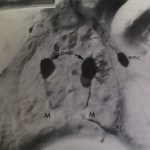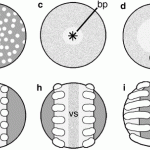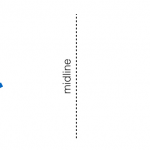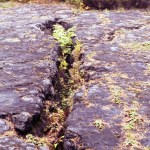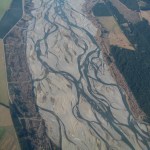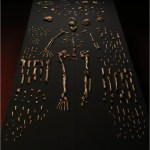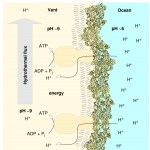evolution
I know this is a horrible photo -- I just snapped a picture of the journal hardcopy, which I own, instead of grabbing a PDF from the web, because it's from 1985 and I'd have to pay to get a copy of my own paper -- but this is what I was doing in grad school. I started as somebody who was interested in neurons and the nervous system, so what you're seeing is a transverse section of the spinal cord of a zebrafish, with a couple of motoneurons labeled black with a tracer enzyme. I spent most of my time teasing apart how those cells grew and made connections.
But all the while there was this one…
It's my first completely free day of Christmas break! Grades are all submitted, nothing is hanging over my head, but I still got up at 5:30am and needed to do something, so I learned about spider gastrulation.
This was a disgraceful gap in my knowledge -- I've worked on insects and on vertebrates, and am fairly familiar with gastrulation in those kinds of organisms, but one thing I did know is that there's a lot of variation in the details of gastrulation, so every new clade seems to exhibit some novel way of tucking cells in to the early embryo. Spiders do it in a cool way.
There are…
The Discovery Institute thinks axon guidance mechanisms are evidence for intelligent design. I think they just trawl the scientific literature for the words "complex" and "purpose" and get really excited about the imaginary interpretations in their head of papers they don't really understand.
There's no mention of evolution here, nor in the full paper in Science. The paper, however, does use a notable word: purpose. "These findings identify NELL2 as an axon guidance cue and establish Robo3 as a multifunctional regulator of pathfinding that simultaneously mediates NELL2 repulsion, inhibits…
A couple of years ago, I wrote a rebuttal to a crackpot claim for the origin of humans, which I called the MFAP Hypothesis. "MFAP" is short for "monkey fucked a pig", which actually pretty much summarizes the whole idea. Eugene McCarthy (no, not that Eugene McCarthy) assembled a list of superficial similarities between humans and pigs -- hairlessness, protruding noses, "snuggling", that sort of thing -- and concluded that a miscellany of appearances overwhelmed the actual genetic relationships and the absence of a feasible genetic mechanism to permit human-porcine hybridization to lead to…
This is a review of The Story of Life in 25 Fossils: Tales of Intrepid Fossil Hunters and the Wonders of Evolution.
Don Prothero
Fossils are cool. Why? Two very big and complex reasons. First, fossils allow us to reconstruct species that don’t exist any more. This is usually done by studying species that do exist, and using the information we glean from living things to interpret the details of the fossil species, giving it life. Second, fossils tell us about evolutionary change, both by showing us what evolutionary events happened that we would not be able to see in living species, and…
Over the last several months, a lot of great books on fossils and evolution (as in paleontology) have come out. I've selected the best for your consideration. These are great gifts for your favorite science-loving nephew, life science teaching cousin, or local school library. Actually, you might like some of these yourself.
Let's start off with a kid's book: Grandmother Fish: a child's first book of Evolution by Jonathan Tweet.
From the blurb:
Grandmother Fish is the first book to teach evolution to preschoolers. While listening to the story, the child mimics the motions and sounds of our…
Let me tell you the hard part about writing about epigenetics: most of your audience has no idea what you're talking about, but is pretty sure that they can use it, whatever it is, to justify every bit of folk wisdom/nonsensical assumption that they have. So while you're explaining how it's a very real and important biological process that is essential for development and learning and behavior, half your readers are using the biology to confirm their biases about evolution and inheritance, and the other half already know all the basic stuff and want to get to the Evisceration of the Wrong,…
Ken Ham says something stupid and dishonest again.
https://twitter.com/aigkenham/status/662450677625569280
The fish that forgot to evolve? Here’s the difference between observational and historical science: ow.ly/Ug1wU
If you bother to read the awful article, it includes a standard creationist canard: Coelacanths haven't changed a bit over their long history, and this disproves evolution.
Well, this fish apparently forgot to evolve for 65 million years! You see, the living coelacanth is easily recognizable from the fossils. Despite having supposedly “primitive” features, many of these…
The whole dang conference is available in one giant 8 hour video, and here it is.
That's kind of indigestibly huge, so I've been going at it in small pieces. I started with Gabrielle Winters at about 5 hours in, with Cephalopod Neurogenomics: Insights into the Evolution of Complex Brains, just because that's what I'm most interested in. It's a conference for general audiences, so it starts off with a good basic overview of cephalopods and neuroscience and molecular biology, and then, just as it starts getting interesting, the sound cuts out at 15 minutes…and doesn't resume for another 15…
We need more of these, and here's another: Great Adaptations: A Fantastical Collection of Science Poems. It contains short rhyming summaries of scientists' work on adaptations, all nicely illustrated.
Here's one from Sarah Hrdy's work on empathy and cooperation.
Doesn't that make you want to run out and buy it right now? How much would you pay? $5? $10? $25?
Well, you can't. Instead, you have to go to this website and download it for free.
Writing the book was a labor of love, so I hope you love it too! Lastly, because our objective is to get as many people reading and learning about…
Early in the history of this blog, I had a running gag that I'd use every now and then. Basically, it involved humorously extravagant descriptions of how I wanted to hide my face behind a paper bag in sheer embarrassment at the antics of fellow physicians, particularly fellow surgeons. Over time, the gag evolved to my expressing a mock desire to hide my visage behind a metal Doctor Doom-style mask, again, over sheer embarrassment over the idiocy of my colleagues about a scientific issue, again, usually evolution. Sadly, creationist physicians are a very common source of such embarrassment,…
The Intelligent Design Creationists are always getting annoyed at the third word in that label -- they're not creationists, they insist, but something completely different. They're scientists, they think. They're just scientists who favor a different explanation for the diversity of life on Earth than those horrible Darwinist notions. But of course, everything about them just affirms that they're simply jumped-up creationists with airs, from their founding by an evangelical Christian, Phillip Johnson, to their crop of fellows like Paul Nelson and William Dembski, who happily profess their…
John Hawks makes a very good case that Homo naledi is a distinct species from H. erectus. He persuaded me, anyway, and it's well worth reading.
Also entertaining. There is some savage snark in there aimed at Jeffrey Schwartz (oh, man, I've long known Schwartz as a hack, not for his anthropology, but for his atrocious abuse of genetics) and Tim White. Data, evidence, and inside baseball!
This video includes snippets showing exactly what it was like to crawl through those narrow tunnels to get at the Homo naledi fossil site.
No, thank you. Can we get one of those big subway tunnel excavators to the cave? It needs widening.
PBS has already made a two-hour documentary on Homo naledi available for streaming, and will be airing it next week. I haven't had a chance to watch it yet! I'm expected to go do my day job shortly, so it'll have to wait until this evening for me.
I got up all bleary-eyed this morning, and before I got my first sip of coffee, the first thing I saw, blasted across Twitter and all the popular news sites, was the news that a new species of human, Homo naledi has been discovered in South Africa. They have the partial skeletons of 15 different individuals, over 1500 bones, all recovered from a single cave. They're calling it a new and unique species, and further, they're claiming that the site is a ritual burial chamber.
Whoa. Brain is whirling. This thing is all over the net, over night. Better drink more coffee.
OK, that's better.
I'm a…
If you're reluctant to drop $80 on a copy of Zimmer/Emlen's Evolution: Making Sense of Life, here's a deal for you: the NCSE will let you download a chapter for free, the one on macroevolution (pdf). That's a good choice. I run into a fair number of pro-science people who think the macroevolution/microevolution distinction is something made up by creationists (it's not -- it's abused by creationists, but then they mangle a lot of science). The chapter includes a good section on punctuated equilibrium, another topic often battered badly by even people arguing on the side of science, and a bit…
Hey, how about these article titles?
Comet Impacts Really Could Have Been the Catalyst For Life on EarthComet Impacts May Have Produced The Building Blocks For Life On EarthWe Now Know For Sure How Life Began on Earth
We're getting this sudden flurry of articles touting the contribution of organic molecules from cometary sources to the origin of life on Earth. They're all bullshit. The media hype machine is going crazy again over science the journalists haven't thought it through.
There's nothing wrong with the core of the original paper that sparked this frenzy of nonsense: the investigators…
I'm still traveling! I'll be heading to the airport shortly to fly back to Minnesota, so until I get back you'll just have to listen to my talk at Gateway to Reason earlier this month.
Another new study published in Nature Communications shows follows along with the prior post and shows that ancestral dogs were ambush hunters that evolved from forest dwelling animals similar to a mongoose (or a cat).
These early ancestors to dogs were ambush predators. The image shows Hesperocyon (left) and later Sunkahetanka (right). Image from Discovery News, by Mauricio Anton
An international team of researchers studied archived samples of elbows and teeth of multiple species of dogs that lived between 40 - 2 million years ago.…
